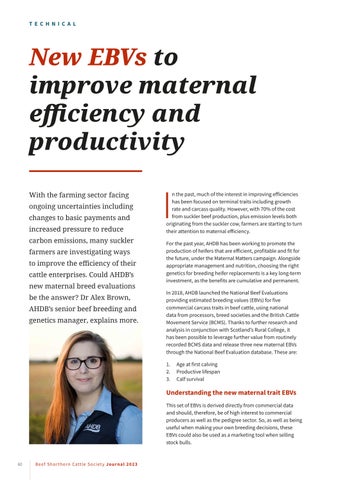T E C H N I C A L
New EBVs to improve maternal efficiency and productivity With the farming sector facing ongoing uncertainties including changes to basic payments and increased pressure to reduce carbon emissions, many suckler farmers are investigating ways to improve the efficiency of their cattle enterprises. Could AHDB’s new maternal breed evaluations be the answer? Dr Alex Brown, AHDB’s senior beef breeding and genetics manager, explains more.
I
n the past, much of the interest in improving efficiencies has been focused on terminal traits including growth rate and carcass quality. However, with 70% of the cost from suckler beef production, plus emission levels both originating from the suckler cow, farmers are starting to turn their attention to maternal efficiency. For the past year, AHDB has been working to promote the production of heifers that are efficient, profitable and fit for the future, under the Maternal Matters campaign. Alongside appropriate management and nutrition, choosing the right genetics for breeding heifer replacements is a key long-term investment, as the benefits are cumulative and permanent. In 2018, AHDB launched the National Beef Evaluations providing estimated breeding values (EBVs) for five commercial carcass traits in beef cattle, using national data from processors, breed societies and the British Cattle Movement Service (BCMS). Thanks to further research and analysis in conjunction with Scotland’s Rural College, it has been possible to leverage further value from routinely recorded BCMS data and release three new maternal EBVs through the National Beef Evaluation database. These are: 1. 2. 3.
Age at first calving Productive lifespan Calf survival
Understanding the new maternal trait EBVs This set of EBVs is derived directly from commercial data and should, therefore, be of high interest to commercial producers as well as the pedigree sector. So, as well as being useful when making your own breeding decisions, these EBVs could also be used as a marketing tool when selling stock bulls.
60
B eef Shorthorn C attl e S oc i ety J o ur n al 2 0 2 3













































